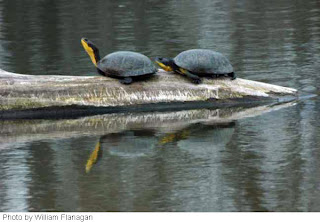1. Texas Tortoise (Gopherus berlandieri)

Notice the gular (throat) fork at the front of
the plastron (undershell)... this is a male.

This is the only "tortoise" in the state of
Texas. It is considered threatened.

G. berlandieri lives in the arid Southern part
of the state.

The Texas Tortoise is closely related
to the Desert and Gopher Tortoises.

A view of the plastron
2. Alligator Snapping Turtle (Macrochelys temminckii)

As you can probably tell from the rather sharp
beak, this is a predatory turtle.

Alligator Snappers are found in the Southeastern
United States.

Alligator Snappers are considered Vulnerable
because of over hunting and habitat destruction.


They have been know to reach an age of
150 years.

The distinctive 3 rows of spiked ridges.

Their meat is highly edible, and they
have been collected in the South for
meat for generations.
3. Florida Softshell Turtle (Apalone ferox)

Softshells have soft cartilaginous shells.

They are know to be fairly plucky and aggressive.

That soft looking mouth harbors a sharp beak,
as softshells are predatory.

Most softshells have a snorkel like nose to aid
in breathing while remaining under water.

A juvenile Florida Softshell

The Florida Softshell is the largest of the
Softshell turtles.
4. Eastern Box Turtle (Terrapene carolina carolina)

This is the common species of Box Turtle in
the Eastern United States. Box Turtles are our
more common terrestrial turtles in the U.S.

Box Turtles are actually not closely
related to Tortoises. They are more
closely related to the Fresh Water
Basking Turtles, like Sliders.

The distinctive red eyes of the male

Box turtles can have poisonous flesh from the
poisonous mushrooms they consume.

Even terrestrial turtles like to bathe.

Notice the yellowish eyes and less colorful face
of the female.

Some Eastern Box Turtles are rather
orange.
5. Blanding's Turtle (Emydoidea blandingii)

The smooth oval shell and Yellow Throat and
chin of The Blanding's Turtle, GORGEOUS!!!

Blanding's may also have yellow spots covering
the carapace (upper shell).

That yellow throat gives them away, even from
a distance.

Blanding's are found in the Central
Northern and north midewestern
states of the U.S.

Speaking of distinctive, look at those bugged
out eyes.

They are Threatened or Endangered through
most of their range, because of Habitat
Degradation.


The plastron of the Blanding's has a
hinge, so that it is capable of closing
slightly.

The juvenile
No comments:
Post a Comment